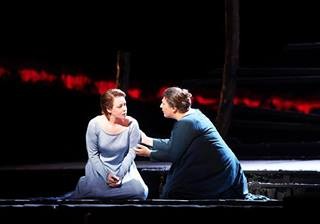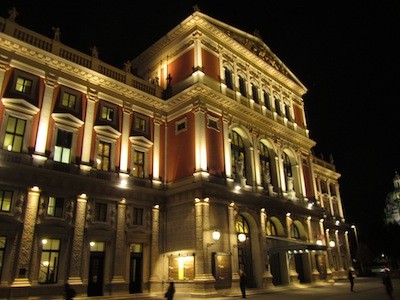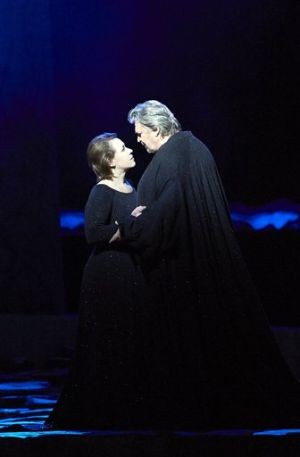Nina Stemme Triumphs as Isolde in Vienna
A Highlight of 200th Anniversary of Wagner's Birth
By: Susan Hall - Jun 21, 2013
Tristan and Isolde
By Richard Wagner
Wiener Staatsoper
Conducted by Franz Welser-Most
Orchestra of Wiener Staatsoper
Chorus, Wiener Staatsoper
June 18, 2013
Cast: Peter Seiffert (Tristan), Stephen Milling (King Mark), Nina Stemme (Isolde), Jochen Schmeckenbecher (Krwenal), Eijiro Kai (Melor), Jnina Baechle (Brangane), Carlos Osuna (Ein Hirt), Marcus Pelz (Ein Steuermann), Jinxu Xiahou (Boatman).
David McVicar (Director), Robert Jones (Sets), Paule Constable (Lights), Andrew George (Choreography), Martin Schebesta (Chorus Master).
Wagner thought that Vienna was the perfect place to premier Tristan and Isolde which he completed in 1859. But the opera proved so complex that it would be years before its premier.
In Vienna 2013, in honor of the 200th anniversary of Wagner’s birth, the Wiener Staatsoper put on a near perfect production of this greatest of love stories.
The reigning Wagnerian soprano, Nina Stemme, sang Isolde with her rich, dramatic soprano, attending every detail of the music and the emotion. Her voice is textured and she moves with seeming ease from intimate quiet to notes which soar over the orchestra. Matching her was a stalwart in the role of Tristan, Peter Seiffert. He is a comfortable performer who was able to respond to the vocal and dramatic demands of the role, one so difficult that this feat is unusual today.
Franz Welser-Most conducted the perhaps most beautiful of all Wagner’s scores in its full dynamic variety. The cellos and horns were particularly beautiful. The chorus was sometimes in a box above the orchestra.
Music came from every direction, including the horns on and off stage. The supporting cast was excellent. Jnina Baechle stood out at Brangane.
The set featured a red moon, which changed to blue and white to match the moods. A puffy cloudlike arc midway on the horizon matched the moon in color, but not texture. Delineation between the earthly and the other earthly was softly articulated, perhaps because it is just as it is in the opera.
The boat carrying Tristan to Cornwall to deliver the bride Isolde to its King was the outline of ship, the construction of the hull revealing its ribcage bent from wood. A prominent prow entered at the beginning of the opera, carrying an angry Iseult off to her arranged marriage with King Mark of Cornwall.
A pile of ragged rocks is stage right. In the second act tryst, the garden is only suggested. A torch is extinguished so that love may flourish. Tristan’s death scene near his castle home in Brittany, to which he has sailed after being wounded by Melot, who has betrayed him is bleak.
The stillness of the set and its beauty provide the perfect backdrop for the opera which musically consummates the greatest of all loves.
David McVicar is a great opera director. This year we have noted his Elektra in Chicago and Julio Cesare in a revival from Glynbourne. Now he has a near perfect triumph in Vienna.
Clearly he was provided with talent across the boards. But to the demands of opera production he brings his willingness to help the singers give dramatic performances. Singers may be charged with conveying the music’s emotion, but McVicar uses any tool that singers can comfortably deploy to convey the drama.
Gesture works particularly well. McVicar in this Tristan appears to have either channeled the gestures painted by Austrian Gustav Klimt, or spent time wandering the rooms of Klimt's paintings in the Belevedere Museum in Vienna.
The paintings' colors are housed in a dark room, as the dark of night which both holds and hugs gesture after gesture on the Tristan stage setting. The gestures can be seen in the Klimts and also in the work of Egon Shiele.
The convincing gestures and postures of Stemme and Seiffert on stage seem lifted from these great paintings. Alone, the anguished or penitent clasp of Iseult’s hands, the strong expanse of Tristan’s open, welcoming arms and especially in the gestures of their bonded passion, gestures painted by Egon Schiele and Klimt are translated on stage to express similar emotions.
Seiffert is a large, handsome man with a ringing, passionate tenor. When he stands behind Iseult for a duet, he clasps her shoulders with a firm, comforting clasp like Klimt painted. When the lovers sang together, from time to time as they speculated about the future, they looked out into the audience as though we were the future.
Never on stage have these lovers more convincingly embraced, in wound arms suggesting Klimt painting called “Embracement.” The gestures were both mythic and hot. Looking at the Klimt painting, you wonder if McVicar sent the singers to the Belvedere for inspiration.
Five hours of wrenching and moving music and performance flew by. Vienna has offered up a perfect tribute to the greatest composer of opera.





